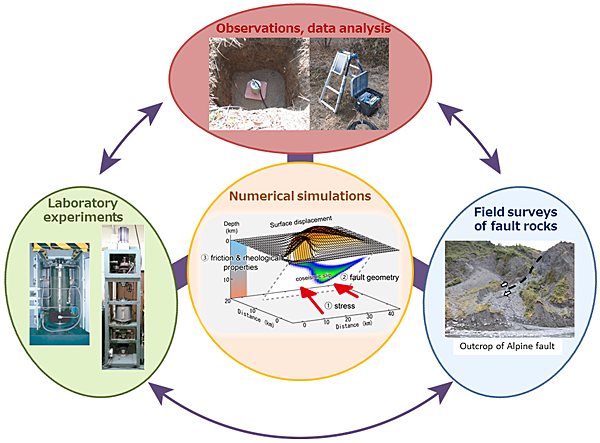 Seismotectonics Research Group
Seismotectonics Research Group
Our group aims to elucidate the physical and mechanical properties of seismogenic zone and the generation processes of large earthquakes by linking field surveys of fault rocks, laboratory experiments, numerical simulations, seismological observations and data analysis. We are currently making a seismotectonic map in Kanto region based on detailed local stress fields, studying the deformation process of fault rocks from brittle to ductile region, and developing the computer simulation technique of earthquake cycles by integrating paleoearthquake information and geophysical data. These studies provide a basis for improving accuracies of long-term earthquake forecasting and evaluating the size of earthquake.

Research approach of our group to elucidate the physical and mechanical properties of seismogenic zone and the generation processes of large earthquakes.
Member
- Takahiko Uchide (Leader, Group)
- Miki Takahashi (Senior Researcher)
- Haruo Horikawa (Senior Researcher)
- Norio Shigematsu (Senior Researcher)
- Yumi Urata (Senior Researcher)
- Takahiro Shiina (Senior Researcher)
- Kiyokazu Ohashi (Senior Researcher)
- Kodai Sagae (AIST Postdoctoral Researcher)
- Mpuang Admore (AIST Postdoctoral Researcher)
- Yukiko Kita (Research Assistant)
- Ryousei Omori (Research Assistant)
- Reiken Matsushita (Technical Staff)
- Hiroshi Terunuma (Technical Staff)
I am interested in earthquake source processes from various points of view, such as the scaling of earthquake rupture growth and frequency-dependent seismic radiation from an earthquake source. I am an expert at seismological data analysis.
I am currently working on, in addition to the above, source properties of small and moderate earthquakes, which may give us a clue to understand past and future large earthquakes on the same active fault.
In order to understand earthquake generation mechanisms, I am measuring the deformation and physical properties of rocks under the high-temperatures and high-pressures in the laboratory. My research interests focus on the frictional behaviors of materials in brittle-plastic transition regions and effects of pore fluid pressure on the frictional behaviors.
I study intraplate earthquakes and related matters, in particular, fault geometry beneath active faults (in the seismogenic layer) and basement structure beneath the sedimentary basins from seismic reflection profiling and source models of historical earthquakes that presumably occurred as intraplate event but do not have records with modern instruments.
I am studying on inland-earthquake generation processes based on the investigation of geological survey of exhumed past hypocentral regions. I will use this information to investigate the processes of deformation of rocks in the laboratory at high pressures and high temperatures to improve accuracy of forecasting a large earthquake occurrence.
I am interested in the physical mechanism of large earthquakes. I work on numerical modeling and simulations using data of a rock friction experiment and of seismological and geodetic observation.
I am investigating internal structures of the Earth based on analyses of seismic waveforms observed for natural earthquakes. By utilizing various types of seismic waves, I try to retrieve fine-scale heterogeneous structures in seismogenic zones and improve understandings for the physical and material conditions that relate to genesis of earthquakes.
I am investigating geometry (structure), mineralogy, and mechanical property of fault zones in multiple time and spatial scales (nm to km, a few seconds to million years), through geological, analytical, and experimental approaches. I am aiming to improve the prediction model of crustal deformation by understanding the mechanical framework, including spatio-temporal heterogeneity of fault zones.
I have determined source locations of tectonic tremors and developed a method for automatically extracting spatio-temporal evolutions of their sources. I aim to elucidate the physical mechanism of the slow earthquake by investigating the growth processes of slow earthquake phenomena (e.g. tectonic tremor) in detail.
I investigate underground structures to better understand the relationship between seismic velocity, tectonics, and earthquake generation in a region. I have analyzed seismic waveforms generated by earthquakes as well as ambient noise to obtain a deeper understanding of seismic velocity changes and the geometry of seismic boundaries in intraplate regions. I also develop seismic waveform inversion techniques for estimating velocity structures.
In order to clarify the physical properties of rocks, I synthesize model materials that simplify the earth's crust to the limit and conduct mechanical experiments. In particular, I focus on the effect of fluids on the strength of rock flow.
I am conducting research to determine the frictional strength of weathered volcanic ash soils that from sliding cliffs.
I am studying automated seismic data processing techniques to improve the accuracy of seismic phase picking and hypocenter determination. So far, I have learned how to manually pick seismic phases, determine hypocenters and magnitudes of earthquakes, unify the data formats of different datasets, etc. On the basis of these experiences, I aim to develop a sophisticated system for automated seismic data processing incorporating various state-of-the-art techniques and hope to contribute towards the elucidation of large earthquake generation mechanism.
Assistant work for the geological studies at the seismotectonics research group.

